7BE002 Strategic Management: Professional Development & Project
VerifiedAdded on 2023/04/21
|50
|7953
|230
Portfolio
AI Summary
This assignment presents a strategic management portfolio comprising two main tasks: a Professional Development Portfolio (PDP) and a Strategic Management Project. The PDP involves a critical reflection on the author's managerial skills, past experiences, and areas for future development, including cross-cultural communication, mindfulness, and navigating bureaucratic corporate cultures, culminating in a personal action plan with short, medium, and long-term goals. The Strategic Management Project includes a business case analysis, literature review, proposed organizational restructure to a horizontal structure, and monitoring mechanisms. The portfolio aims to demonstrate strategic thinking, self-awareness, and practical application of management principles, with the goal of enhancing both personal and professional capabilities.
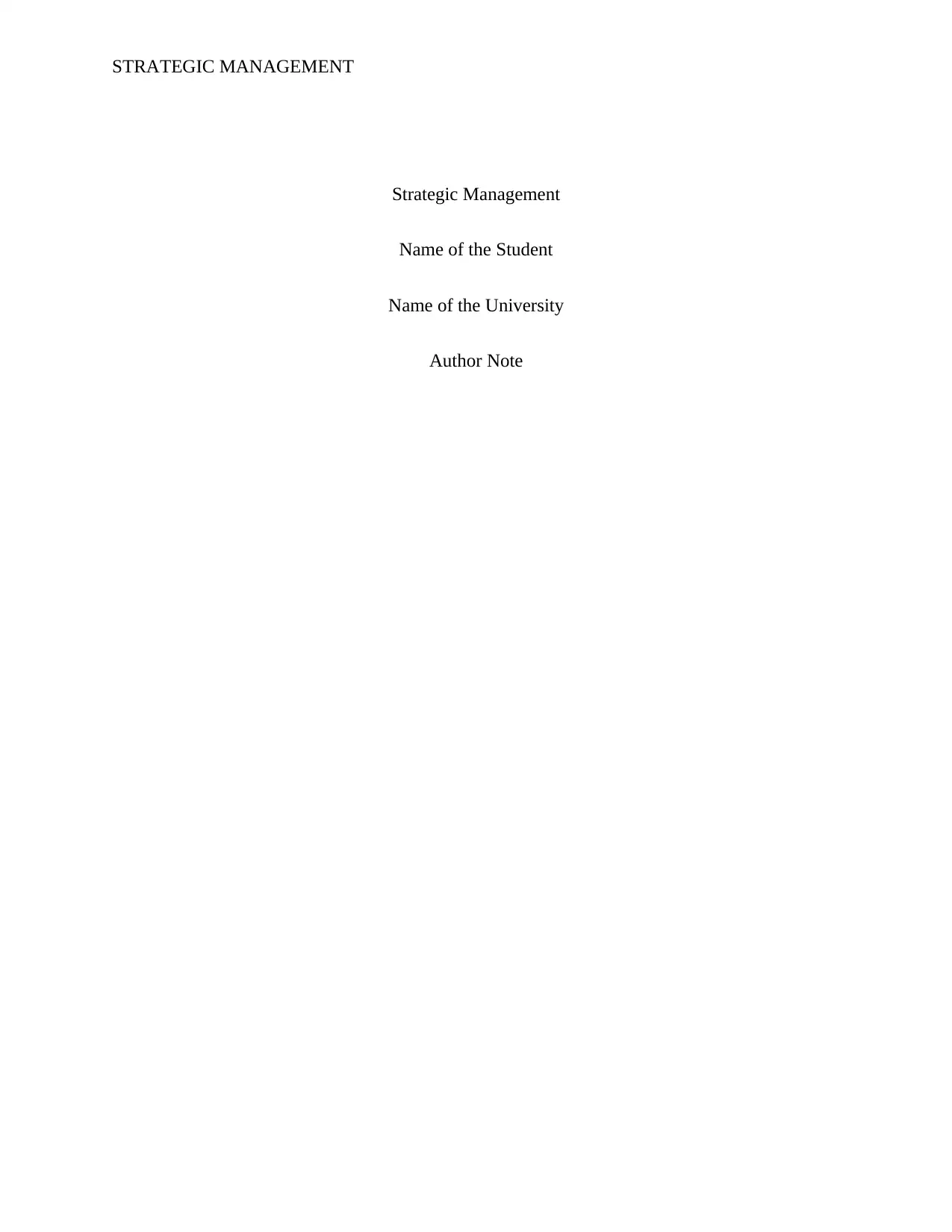
STRATEGIC MANAGEMENT
Strategic Management
Name of the Student
Name of the University
Author Note
Strategic Management
Name of the Student
Name of the University
Author Note
Paraphrase This Document
Need a fresh take? Get an instant paraphrase of this document with our AI Paraphraser
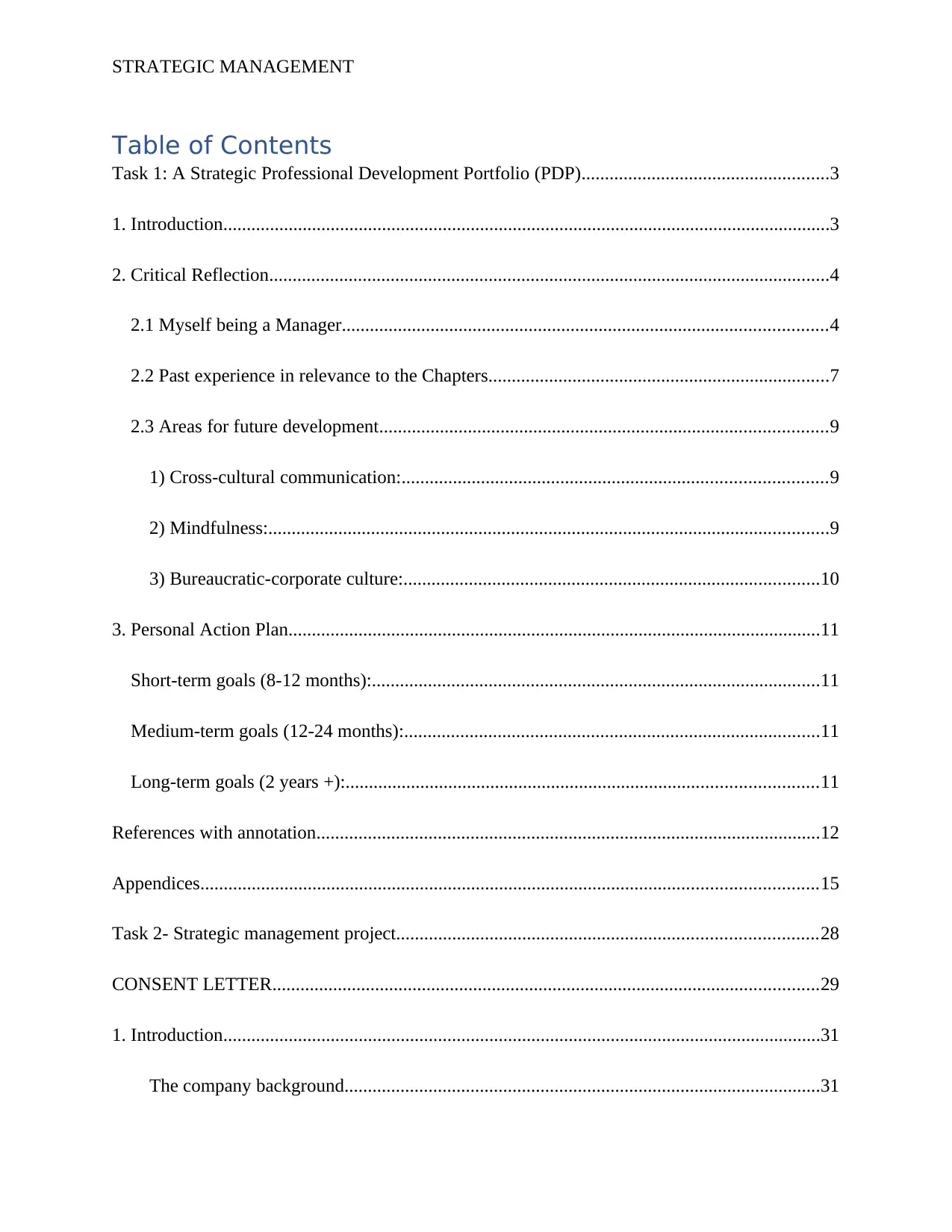
STRATEGIC MANAGEMENT
Table of Contents
Task 1: A Strategic Professional Development Portfolio (PDP).....................................................3
1. Introduction..................................................................................................................................3
2. Critical Reflection........................................................................................................................4
2.1 Myself being a Manager........................................................................................................4
2.2 Past experience in relevance to the Chapters.........................................................................7
2.3 Areas for future development................................................................................................9
1) Cross-cultural communication:...........................................................................................9
2) Mindfulness:........................................................................................................................9
3) Bureaucratic-corporate culture:.........................................................................................10
3. Personal Action Plan..................................................................................................................11
Short-term goals (8-12 months):................................................................................................11
Medium-term goals (12-24 months):.........................................................................................11
Long-term goals (2 years +):.....................................................................................................11
References with annotation............................................................................................................12
Appendices....................................................................................................................................15
Task 2- Strategic management project..........................................................................................28
CONSENT LETTER.....................................................................................................................29
1. Introduction................................................................................................................................31
The company background......................................................................................................31
Table of Contents
Task 1: A Strategic Professional Development Portfolio (PDP).....................................................3
1. Introduction..................................................................................................................................3
2. Critical Reflection........................................................................................................................4
2.1 Myself being a Manager........................................................................................................4
2.2 Past experience in relevance to the Chapters.........................................................................7
2.3 Areas for future development................................................................................................9
1) Cross-cultural communication:...........................................................................................9
2) Mindfulness:........................................................................................................................9
3) Bureaucratic-corporate culture:.........................................................................................10
3. Personal Action Plan..................................................................................................................11
Short-term goals (8-12 months):................................................................................................11
Medium-term goals (12-24 months):.........................................................................................11
Long-term goals (2 years +):.....................................................................................................11
References with annotation............................................................................................................12
Appendices....................................................................................................................................15
Task 2- Strategic management project..........................................................................................28
CONSENT LETTER.....................................................................................................................29
1. Introduction................................................................................................................................31
The company background......................................................................................................31
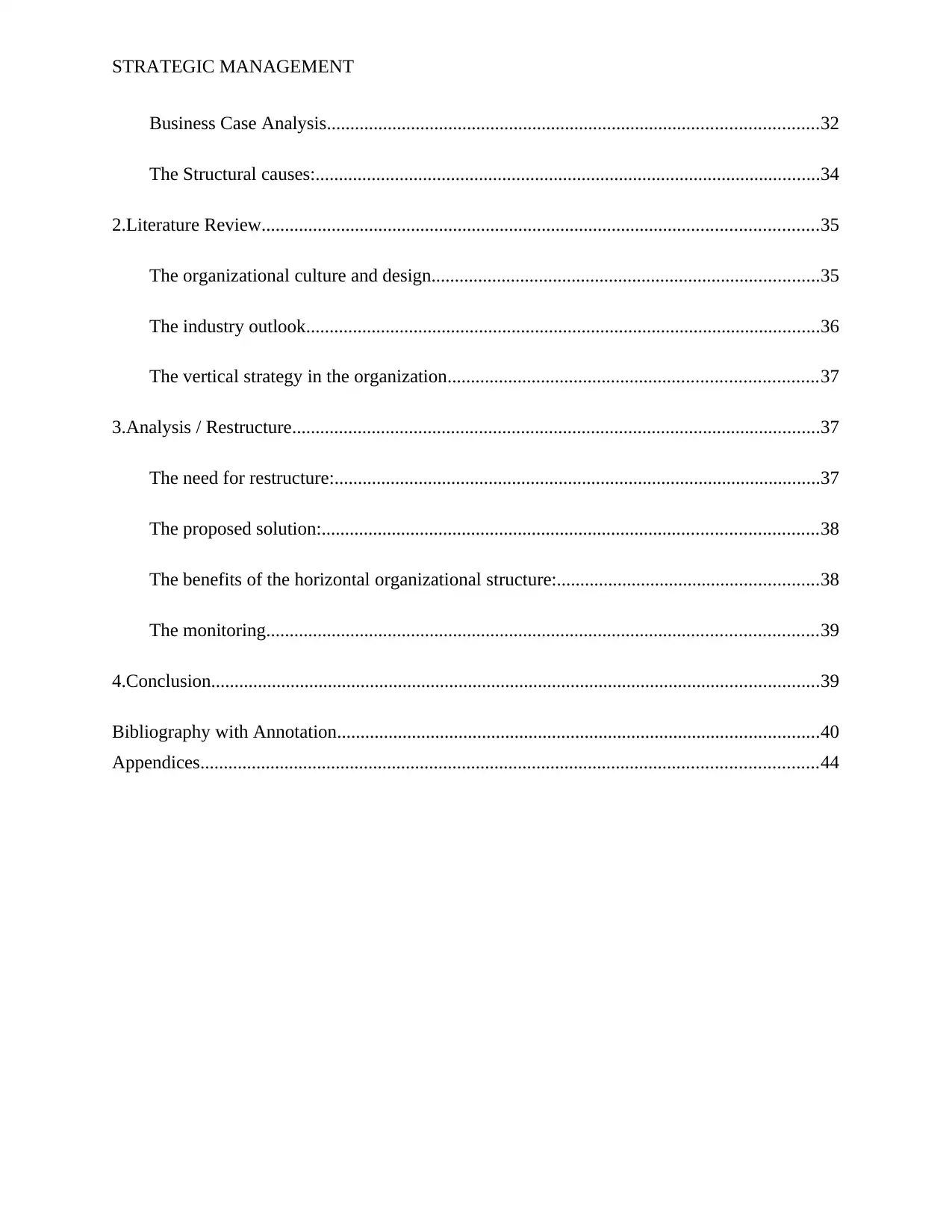
STRATEGIC MANAGEMENT
Business Case Analysis.........................................................................................................32
The Structural causes:............................................................................................................34
2.Literature Review.......................................................................................................................35
The organizational culture and design...................................................................................35
The industry outlook..............................................................................................................36
The vertical strategy in the organization...............................................................................37
3.Analysis / Restructure.................................................................................................................37
The need for restructure:........................................................................................................37
The proposed solution:..........................................................................................................38
The benefits of the horizontal organizational structure:........................................................38
The monitoring......................................................................................................................39
4.Conclusion..................................................................................................................................39
Bibliography with Annotation.......................................................................................................40
Appendices....................................................................................................................................44
Business Case Analysis.........................................................................................................32
The Structural causes:............................................................................................................34
2.Literature Review.......................................................................................................................35
The organizational culture and design...................................................................................35
The industry outlook..............................................................................................................36
The vertical strategy in the organization...............................................................................37
3.Analysis / Restructure.................................................................................................................37
The need for restructure:........................................................................................................37
The proposed solution:..........................................................................................................38
The benefits of the horizontal organizational structure:........................................................38
The monitoring......................................................................................................................39
4.Conclusion..................................................................................................................................39
Bibliography with Annotation.......................................................................................................40
Appendices....................................................................................................................................44
⊘ This is a preview!⊘
Do you want full access?
Subscribe today to unlock all pages.

Trusted by 1+ million students worldwide
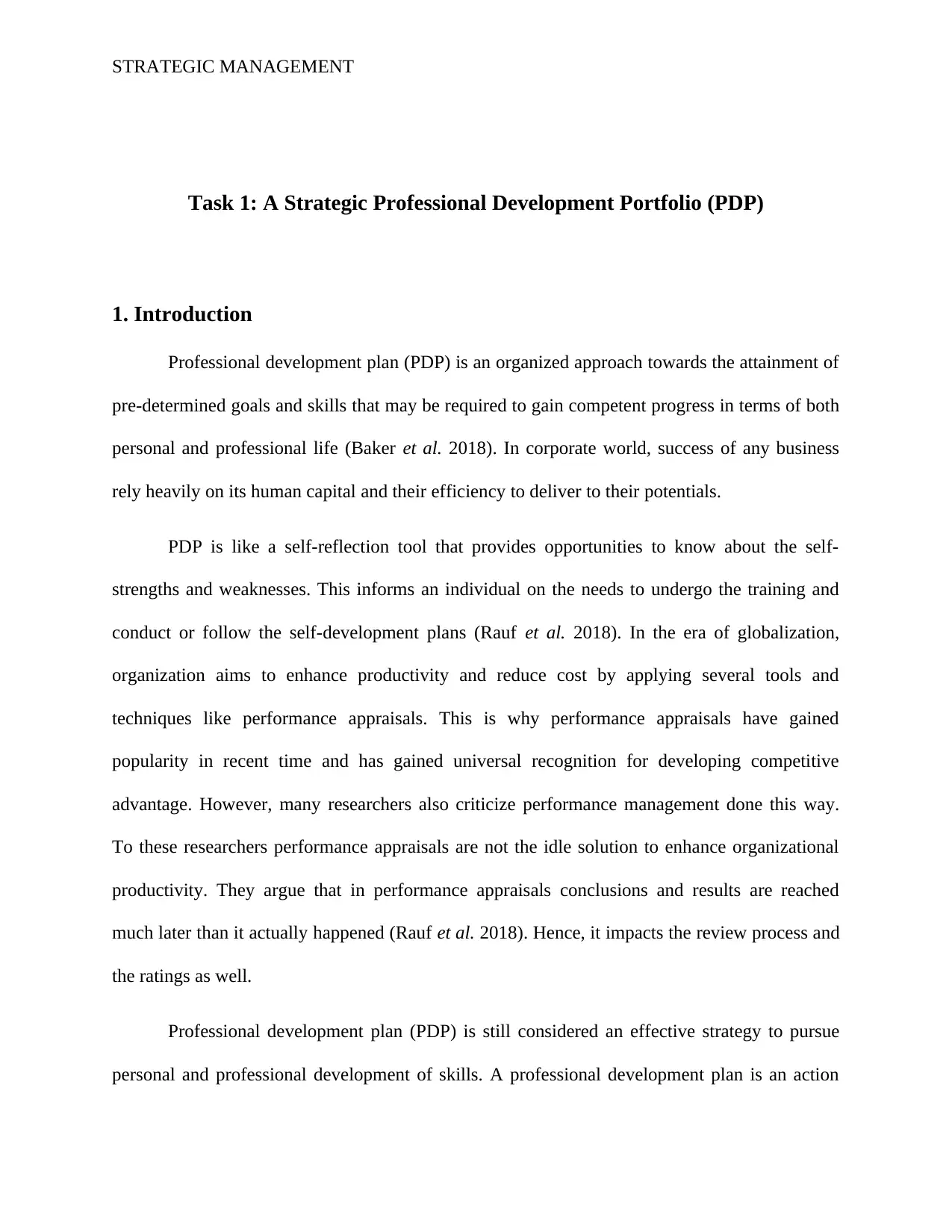
STRATEGIC MANAGEMENT
Task 1: A Strategic Professional Development Portfolio (PDP)
1. Introduction
Professional development plan (PDP) is an organized approach towards the attainment of
pre-determined goals and skills that may be required to gain competent progress in terms of both
personal and professional life (Baker et al. 2018). In corporate world, success of any business
rely heavily on its human capital and their efficiency to deliver to their potentials.
PDP is like a self-reflection tool that provides opportunities to know about the self-
strengths and weaknesses. This informs an individual on the needs to undergo the training and
conduct or follow the self-development plans (Rauf et al. 2018). In the era of globalization,
organization aims to enhance productivity and reduce cost by applying several tools and
techniques like performance appraisals. This is why performance appraisals have gained
popularity in recent time and has gained universal recognition for developing competitive
advantage. However, many researchers also criticize performance management done this way.
To these researchers performance appraisals are not the idle solution to enhance organizational
productivity. They argue that in performance appraisals conclusions and results are reached
much later than it actually happened (Rauf et al. 2018). Hence, it impacts the review process and
the ratings as well.
Professional development plan (PDP) is still considered an effective strategy to pursue
personal and professional development of skills. A professional development plan is an action
Task 1: A Strategic Professional Development Portfolio (PDP)
1. Introduction
Professional development plan (PDP) is an organized approach towards the attainment of
pre-determined goals and skills that may be required to gain competent progress in terms of both
personal and professional life (Baker et al. 2018). In corporate world, success of any business
rely heavily on its human capital and their efficiency to deliver to their potentials.
PDP is like a self-reflection tool that provides opportunities to know about the self-
strengths and weaknesses. This informs an individual on the needs to undergo the training and
conduct or follow the self-development plans (Rauf et al. 2018). In the era of globalization,
organization aims to enhance productivity and reduce cost by applying several tools and
techniques like performance appraisals. This is why performance appraisals have gained
popularity in recent time and has gained universal recognition for developing competitive
advantage. However, many researchers also criticize performance management done this way.
To these researchers performance appraisals are not the idle solution to enhance organizational
productivity. They argue that in performance appraisals conclusions and results are reached
much later than it actually happened (Rauf et al. 2018). Hence, it impacts the review process and
the ratings as well.
Professional development plan (PDP) is still considered an effective strategy to pursue
personal and professional development of skills. A professional development plan is an action
Paraphrase This Document
Need a fresh take? Get an instant paraphrase of this document with our AI Paraphraser
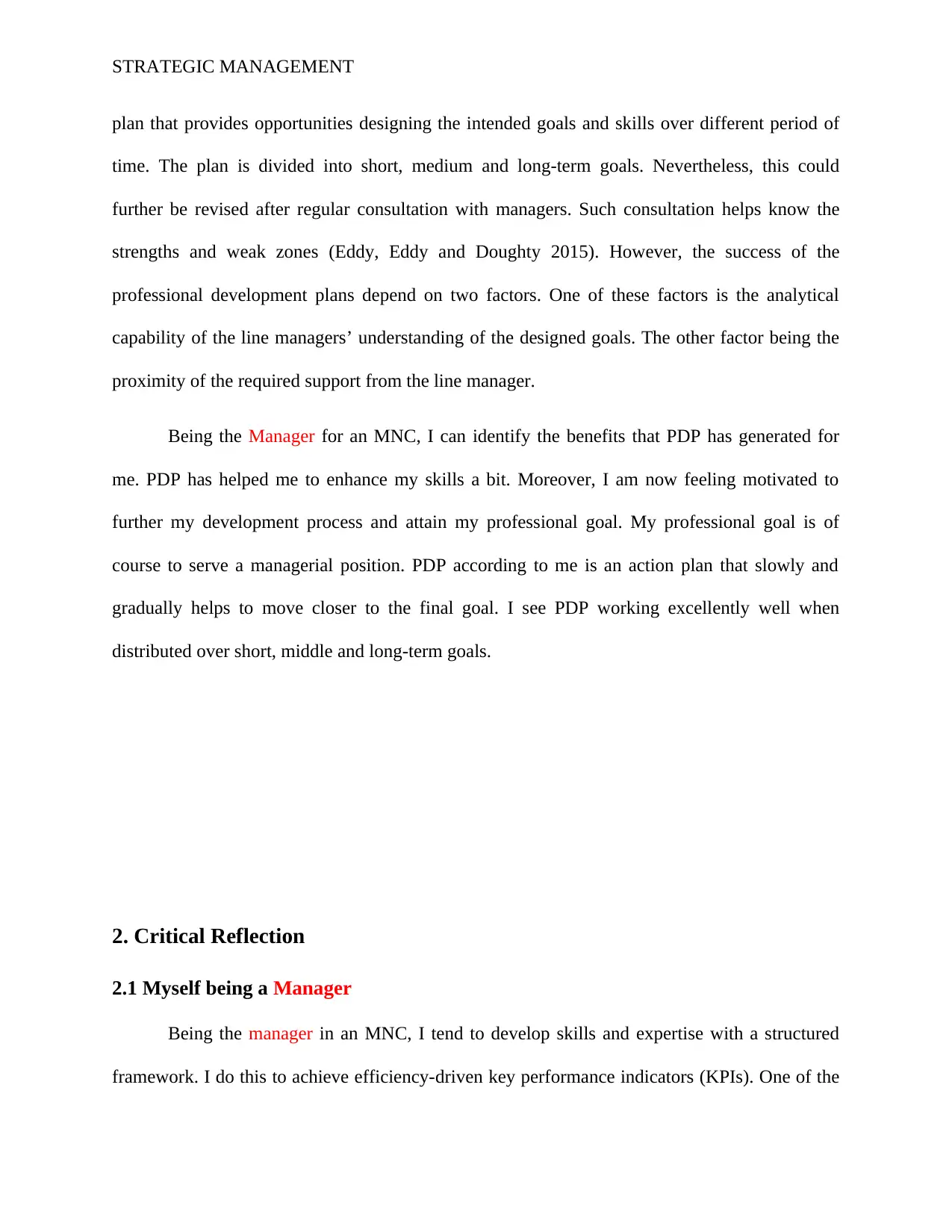
STRATEGIC MANAGEMENT
plan that provides opportunities designing the intended goals and skills over different period of
time. The plan is divided into short, medium and long-term goals. Nevertheless, this could
further be revised after regular consultation with managers. Such consultation helps know the
strengths and weak zones (Eddy, Eddy and Doughty 2015). However, the success of the
professional development plans depend on two factors. One of these factors is the analytical
capability of the line managers’ understanding of the designed goals. The other factor being the
proximity of the required support from the line manager.
Being the Manager for an MNC, I can identify the benefits that PDP has generated for
me. PDP has helped me to enhance my skills a bit. Moreover, I am now feeling motivated to
further my development process and attain my professional goal. My professional goal is of
course to serve a managerial position. PDP according to me is an action plan that slowly and
gradually helps to move closer to the final goal. I see PDP working excellently well when
distributed over short, middle and long-term goals.
2. Critical Reflection
2.1 Myself being a Manager
Being the manager in an MNC, I tend to develop skills and expertise with a structured
framework. I do this to achieve efficiency-driven key performance indicators (KPIs). One of the
plan that provides opportunities designing the intended goals and skills over different period of
time. The plan is divided into short, medium and long-term goals. Nevertheless, this could
further be revised after regular consultation with managers. Such consultation helps know the
strengths and weak zones (Eddy, Eddy and Doughty 2015). However, the success of the
professional development plans depend on two factors. One of these factors is the analytical
capability of the line managers’ understanding of the designed goals. The other factor being the
proximity of the required support from the line manager.
Being the Manager for an MNC, I can identify the benefits that PDP has generated for
me. PDP has helped me to enhance my skills a bit. Moreover, I am now feeling motivated to
further my development process and attain my professional goal. My professional goal is of
course to serve a managerial position. PDP according to me is an action plan that slowly and
gradually helps to move closer to the final goal. I see PDP working excellently well when
distributed over short, middle and long-term goals.
2. Critical Reflection
2.1 Myself being a Manager
Being the manager in an MNC, I tend to develop skills and expertise with a structured
framework. I do this to achieve efficiency-driven key performance indicators (KPIs). One of the
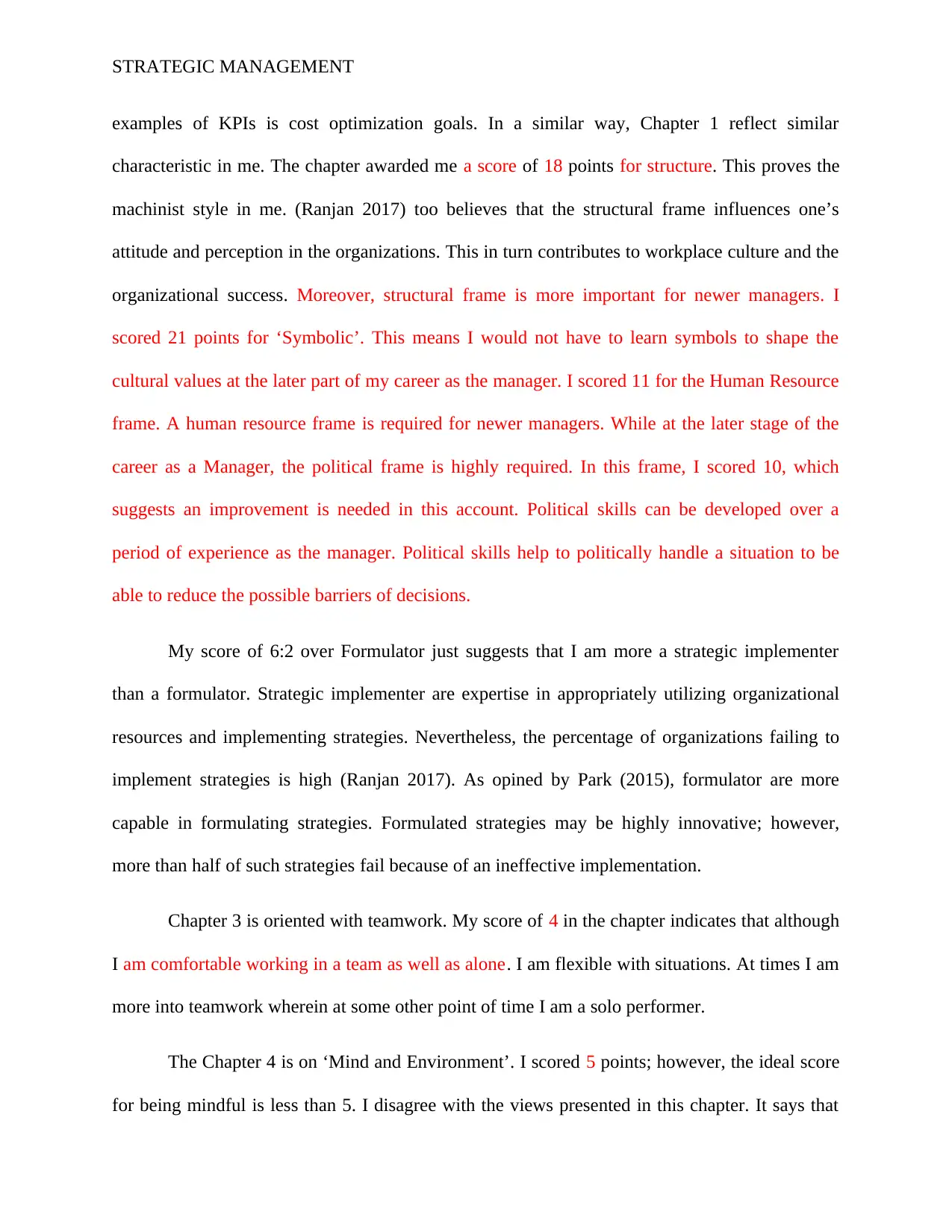
STRATEGIC MANAGEMENT
examples of KPIs is cost optimization goals. In a similar way, Chapter 1 reflect similar
characteristic in me. The chapter awarded me a score of 18 points for structure. This proves the
machinist style in me. (Ranjan 2017) too believes that the structural frame influences one’s
attitude and perception in the organizations. This in turn contributes to workplace culture and the
organizational success. Moreover, structural frame is more important for newer managers. I
scored 21 points for ‘Symbolic’. This means I would not have to learn symbols to shape the
cultural values at the later part of my career as the manager. I scored 11 for the Human Resource
frame. A human resource frame is required for newer managers. While at the later stage of the
career as a Manager, the political frame is highly required. In this frame, I scored 10, which
suggests an improvement is needed in this account. Political skills can be developed over a
period of experience as the manager. Political skills help to politically handle a situation to be
able to reduce the possible barriers of decisions.
My score of 6:2 over Formulator just suggests that I am more a strategic implementer
than a formulator. Strategic implementer are expertise in appropriately utilizing organizational
resources and implementing strategies. Nevertheless, the percentage of organizations failing to
implement strategies is high (Ranjan 2017). As opined by Park (2015), formulator are more
capable in formulating strategies. Formulated strategies may be highly innovative; however,
more than half of such strategies fail because of an ineffective implementation.
Chapter 3 is oriented with teamwork. My score of 4 in the chapter indicates that although
I am comfortable working in a team as well as alone. I am flexible with situations. At times I am
more into teamwork wherein at some other point of time I am a solo performer.
The Chapter 4 is on ‘Mind and Environment’. I scored 5 points; however, the ideal score
for being mindful is less than 5. I disagree with the views presented in this chapter. It says that
examples of KPIs is cost optimization goals. In a similar way, Chapter 1 reflect similar
characteristic in me. The chapter awarded me a score of 18 points for structure. This proves the
machinist style in me. (Ranjan 2017) too believes that the structural frame influences one’s
attitude and perception in the organizations. This in turn contributes to workplace culture and the
organizational success. Moreover, structural frame is more important for newer managers. I
scored 21 points for ‘Symbolic’. This means I would not have to learn symbols to shape the
cultural values at the later part of my career as the manager. I scored 11 for the Human Resource
frame. A human resource frame is required for newer managers. While at the later stage of the
career as a Manager, the political frame is highly required. In this frame, I scored 10, which
suggests an improvement is needed in this account. Political skills can be developed over a
period of experience as the manager. Political skills help to politically handle a situation to be
able to reduce the possible barriers of decisions.
My score of 6:2 over Formulator just suggests that I am more a strategic implementer
than a formulator. Strategic implementer are expertise in appropriately utilizing organizational
resources and implementing strategies. Nevertheless, the percentage of organizations failing to
implement strategies is high (Ranjan 2017). As opined by Park (2015), formulator are more
capable in formulating strategies. Formulated strategies may be highly innovative; however,
more than half of such strategies fail because of an ineffective implementation.
Chapter 3 is oriented with teamwork. My score of 4 in the chapter indicates that although
I am comfortable working in a team as well as alone. I am flexible with situations. At times I am
more into teamwork wherein at some other point of time I am a solo performer.
The Chapter 4 is on ‘Mind and Environment’. I scored 5 points; however, the ideal score
for being mindful is less than 5. I disagree with the views presented in this chapter. It says that
⊘ This is a preview!⊘
Do you want full access?
Subscribe today to unlock all pages.

Trusted by 1+ million students worldwide
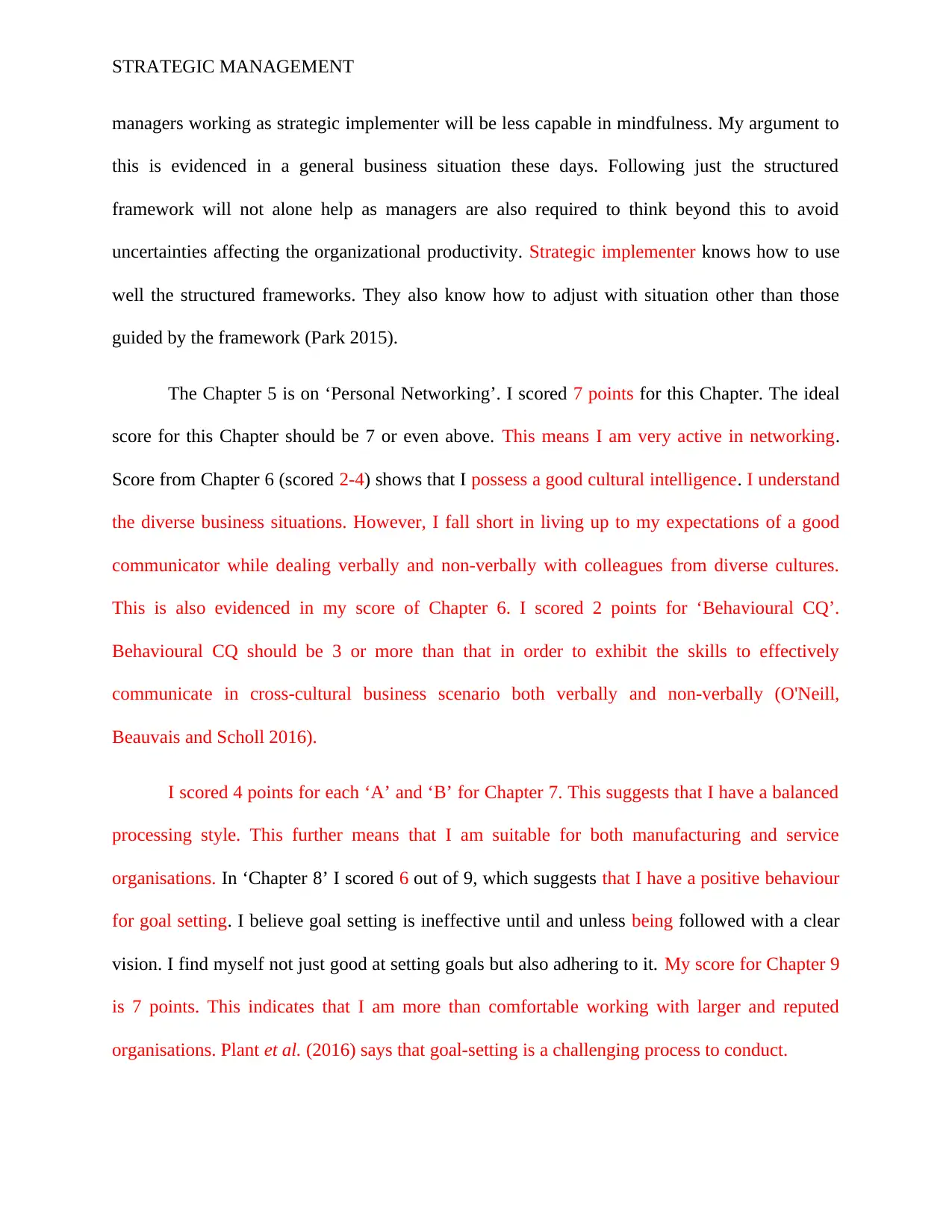
STRATEGIC MANAGEMENT
managers working as strategic implementer will be less capable in mindfulness. My argument to
this is evidenced in a general business situation these days. Following just the structured
framework will not alone help as managers are also required to think beyond this to avoid
uncertainties affecting the organizational productivity. Strategic implementer knows how to use
well the structured frameworks. They also know how to adjust with situation other than those
guided by the framework (Park 2015).
The Chapter 5 is on ‘Personal Networking’. I scored 7 points for this Chapter. The ideal
score for this Chapter should be 7 or even above. This means I am very active in networking.
Score from Chapter 6 (scored 2-4) shows that I possess a good cultural intelligence. I understand
the diverse business situations. However, I fall short in living up to my expectations of a good
communicator while dealing verbally and non-verbally with colleagues from diverse cultures.
This is also evidenced in my score of Chapter 6. I scored 2 points for ‘Behavioural CQ’.
Behavioural CQ should be 3 or more than that in order to exhibit the skills to effectively
communicate in cross-cultural business scenario both verbally and non-verbally (O'Neill,
Beauvais and Scholl 2016).
I scored 4 points for each ‘A’ and ‘B’ for Chapter 7. This suggests that I have a balanced
processing style. This further means that I am suitable for both manufacturing and service
organisations. In ‘Chapter 8’ I scored 6 out of 9, which suggests that I have a positive behaviour
for goal setting. I believe goal setting is ineffective until and unless being followed with a clear
vision. I find myself not just good at setting goals but also adhering to it. My score for Chapter 9
is 7 points. This indicates that I am more than comfortable working with larger and reputed
organisations. Plant et al. (2016) says that goal-setting is a challenging process to conduct.
managers working as strategic implementer will be less capable in mindfulness. My argument to
this is evidenced in a general business situation these days. Following just the structured
framework will not alone help as managers are also required to think beyond this to avoid
uncertainties affecting the organizational productivity. Strategic implementer knows how to use
well the structured frameworks. They also know how to adjust with situation other than those
guided by the framework (Park 2015).
The Chapter 5 is on ‘Personal Networking’. I scored 7 points for this Chapter. The ideal
score for this Chapter should be 7 or even above. This means I am very active in networking.
Score from Chapter 6 (scored 2-4) shows that I possess a good cultural intelligence. I understand
the diverse business situations. However, I fall short in living up to my expectations of a good
communicator while dealing verbally and non-verbally with colleagues from diverse cultures.
This is also evidenced in my score of Chapter 6. I scored 2 points for ‘Behavioural CQ’.
Behavioural CQ should be 3 or more than that in order to exhibit the skills to effectively
communicate in cross-cultural business scenario both verbally and non-verbally (O'Neill,
Beauvais and Scholl 2016).
I scored 4 points for each ‘A’ and ‘B’ for Chapter 7. This suggests that I have a balanced
processing style. This further means that I am suitable for both manufacturing and service
organisations. In ‘Chapter 8’ I scored 6 out of 9, which suggests that I have a positive behaviour
for goal setting. I believe goal setting is ineffective until and unless being followed with a clear
vision. I find myself not just good at setting goals but also adhering to it. My score for Chapter 9
is 7 points. This indicates that I am more than comfortable working with larger and reputed
organisations. Plant et al. (2016) says that goal-setting is a challenging process to conduct.
Paraphrase This Document
Need a fresh take? Get an instant paraphrase of this document with our AI Paraphraser
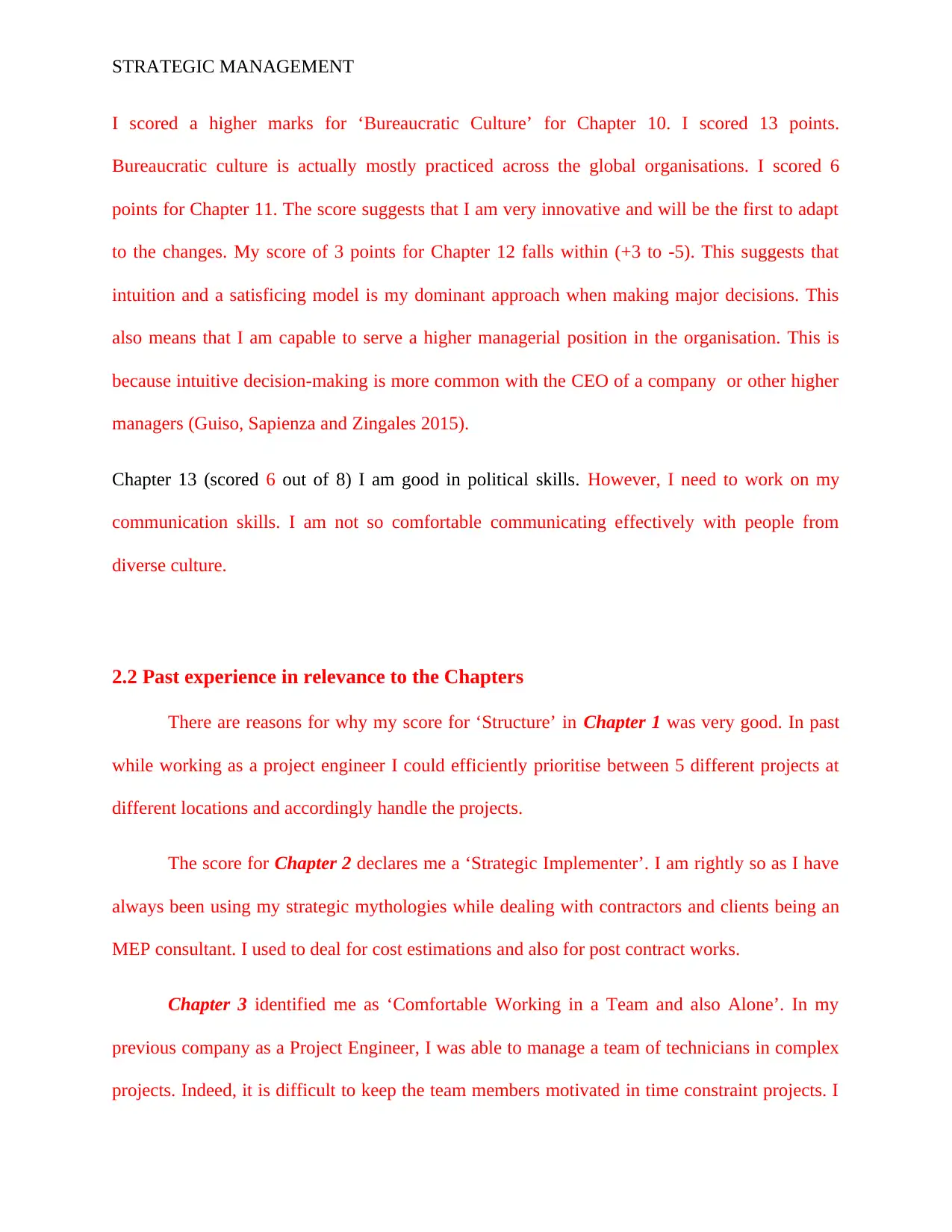
STRATEGIC MANAGEMENT
I scored a higher marks for ‘Bureaucratic Culture’ for Chapter 10. I scored 13 points.
Bureaucratic culture is actually mostly practiced across the global organisations. I scored 6
points for Chapter 11. The score suggests that I am very innovative and will be the first to adapt
to the changes. My score of 3 points for Chapter 12 falls within (+3 to -5). This suggests that
intuition and a satisficing model is my dominant approach when making major decisions. This
also means that I am capable to serve a higher managerial position in the organisation. This is
because intuitive decision-making is more common with the CEO of a company or other higher
managers (Guiso, Sapienza and Zingales 2015).
Chapter 13 (scored 6 out of 8) I am good in political skills. However, I need to work on my
communication skills. I am not so comfortable communicating effectively with people from
diverse culture.
2.2 Past experience in relevance to the Chapters
There are reasons for why my score for ‘Structure’ in Chapter 1 was very good. In past
while working as a project engineer I could efficiently prioritise between 5 different projects at
different locations and accordingly handle the projects.
The score for Chapter 2 declares me a ‘Strategic Implementer’. I am rightly so as I have
always been using my strategic mythologies while dealing with contractors and clients being an
MEP consultant. I used to deal for cost estimations and also for post contract works.
Chapter 3 identified me as ‘Comfortable Working in a Team and also Alone’. In my
previous company as a Project Engineer, I was able to manage a team of technicians in complex
projects. Indeed, it is difficult to keep the team members motivated in time constraint projects. I
I scored a higher marks for ‘Bureaucratic Culture’ for Chapter 10. I scored 13 points.
Bureaucratic culture is actually mostly practiced across the global organisations. I scored 6
points for Chapter 11. The score suggests that I am very innovative and will be the first to adapt
to the changes. My score of 3 points for Chapter 12 falls within (+3 to -5). This suggests that
intuition and a satisficing model is my dominant approach when making major decisions. This
also means that I am capable to serve a higher managerial position in the organisation. This is
because intuitive decision-making is more common with the CEO of a company or other higher
managers (Guiso, Sapienza and Zingales 2015).
Chapter 13 (scored 6 out of 8) I am good in political skills. However, I need to work on my
communication skills. I am not so comfortable communicating effectively with people from
diverse culture.
2.2 Past experience in relevance to the Chapters
There are reasons for why my score for ‘Structure’ in Chapter 1 was very good. In past
while working as a project engineer I could efficiently prioritise between 5 different projects at
different locations and accordingly handle the projects.
The score for Chapter 2 declares me a ‘Strategic Implementer’. I am rightly so as I have
always been using my strategic mythologies while dealing with contractors and clients being an
MEP consultant. I used to deal for cost estimations and also for post contract works.
Chapter 3 identified me as ‘Comfortable Working in a Team and also Alone’. In my
previous company as a Project Engineer, I was able to manage a team of technicians in complex
projects. Indeed, it is difficult to keep the team members motivated in time constraint projects. I
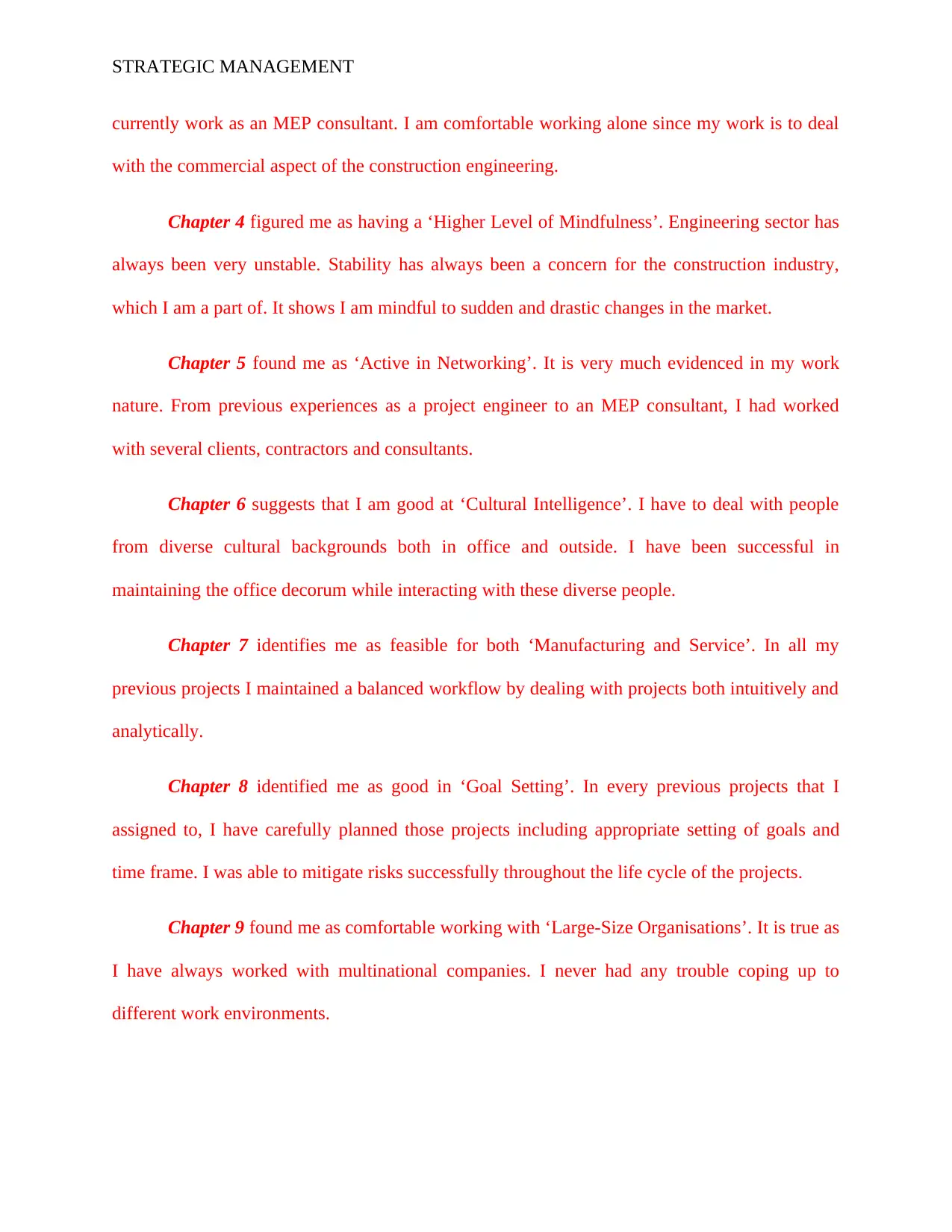
STRATEGIC MANAGEMENT
currently work as an MEP consultant. I am comfortable working alone since my work is to deal
with the commercial aspect of the construction engineering.
Chapter 4 figured me as having a ‘Higher Level of Mindfulness’. Engineering sector has
always been very unstable. Stability has always been a concern for the construction industry,
which I am a part of. It shows I am mindful to sudden and drastic changes in the market.
Chapter 5 found me as ‘Active in Networking’. It is very much evidenced in my work
nature. From previous experiences as a project engineer to an MEP consultant, I had worked
with several clients, contractors and consultants.
Chapter 6 suggests that I am good at ‘Cultural Intelligence’. I have to deal with people
from diverse cultural backgrounds both in office and outside. I have been successful in
maintaining the office decorum while interacting with these diverse people.
Chapter 7 identifies me as feasible for both ‘Manufacturing and Service’. In all my
previous projects I maintained a balanced workflow by dealing with projects both intuitively and
analytically.
Chapter 8 identified me as good in ‘Goal Setting’. In every previous projects that I
assigned to, I have carefully planned those projects including appropriate setting of goals and
time frame. I was able to mitigate risks successfully throughout the life cycle of the projects.
Chapter 9 found me as comfortable working with ‘Large-Size Organisations’. It is true as
I have always worked with multinational companies. I never had any trouble coping up to
different work environments.
currently work as an MEP consultant. I am comfortable working alone since my work is to deal
with the commercial aspect of the construction engineering.
Chapter 4 figured me as having a ‘Higher Level of Mindfulness’. Engineering sector has
always been very unstable. Stability has always been a concern for the construction industry,
which I am a part of. It shows I am mindful to sudden and drastic changes in the market.
Chapter 5 found me as ‘Active in Networking’. It is very much evidenced in my work
nature. From previous experiences as a project engineer to an MEP consultant, I had worked
with several clients, contractors and consultants.
Chapter 6 suggests that I am good at ‘Cultural Intelligence’. I have to deal with people
from diverse cultural backgrounds both in office and outside. I have been successful in
maintaining the office decorum while interacting with these diverse people.
Chapter 7 identifies me as feasible for both ‘Manufacturing and Service’. In all my
previous projects I maintained a balanced workflow by dealing with projects both intuitively and
analytically.
Chapter 8 identified me as good in ‘Goal Setting’. In every previous projects that I
assigned to, I have carefully planned those projects including appropriate setting of goals and
time frame. I was able to mitigate risks successfully throughout the life cycle of the projects.
Chapter 9 found me as comfortable working with ‘Large-Size Organisations’. It is true as
I have always worked with multinational companies. I never had any trouble coping up to
different work environments.
⊘ This is a preview!⊘
Do you want full access?
Subscribe today to unlock all pages.

Trusted by 1+ million students worldwide
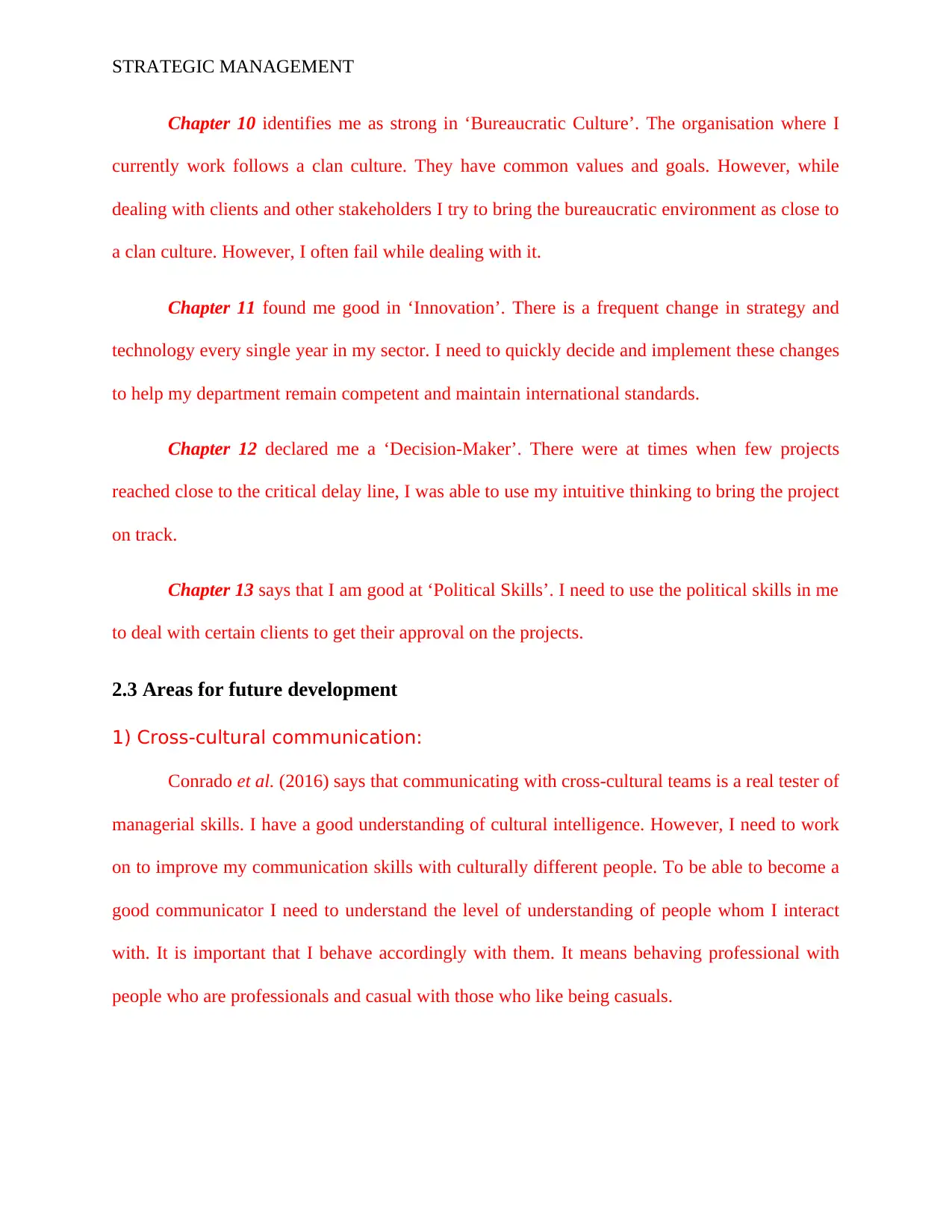
STRATEGIC MANAGEMENT
Chapter 10 identifies me as strong in ‘Bureaucratic Culture’. The organisation where I
currently work follows a clan culture. They have common values and goals. However, while
dealing with clients and other stakeholders I try to bring the bureaucratic environment as close to
a clan culture. However, I often fail while dealing with it.
Chapter 11 found me good in ‘Innovation’. There is a frequent change in strategy and
technology every single year in my sector. I need to quickly decide and implement these changes
to help my department remain competent and maintain international standards.
Chapter 12 declared me a ‘Decision-Maker’. There were at times when few projects
reached close to the critical delay line, I was able to use my intuitive thinking to bring the project
on track.
Chapter 13 says that I am good at ‘Political Skills’. I need to use the political skills in me
to deal with certain clients to get their approval on the projects.
2.3 Areas for future development
1) Cross-cultural communication:
Conrado et al. (2016) says that communicating with cross-cultural teams is a real tester of
managerial skills. I have a good understanding of cultural intelligence. However, I need to work
on to improve my communication skills with culturally different people. To be able to become a
good communicator I need to understand the level of understanding of people whom I interact
with. It is important that I behave accordingly with them. It means behaving professional with
people who are professionals and casual with those who like being casuals.
Chapter 10 identifies me as strong in ‘Bureaucratic Culture’. The organisation where I
currently work follows a clan culture. They have common values and goals. However, while
dealing with clients and other stakeholders I try to bring the bureaucratic environment as close to
a clan culture. However, I often fail while dealing with it.
Chapter 11 found me good in ‘Innovation’. There is a frequent change in strategy and
technology every single year in my sector. I need to quickly decide and implement these changes
to help my department remain competent and maintain international standards.
Chapter 12 declared me a ‘Decision-Maker’. There were at times when few projects
reached close to the critical delay line, I was able to use my intuitive thinking to bring the project
on track.
Chapter 13 says that I am good at ‘Political Skills’. I need to use the political skills in me
to deal with certain clients to get their approval on the projects.
2.3 Areas for future development
1) Cross-cultural communication:
Conrado et al. (2016) says that communicating with cross-cultural teams is a real tester of
managerial skills. I have a good understanding of cultural intelligence. However, I need to work
on to improve my communication skills with culturally different people. To be able to become a
good communicator I need to understand the level of understanding of people whom I interact
with. It is important that I behave accordingly with them. It means behaving professional with
people who are professionals and casual with those who like being casuals.
Paraphrase This Document
Need a fresh take? Get an instant paraphrase of this document with our AI Paraphraser
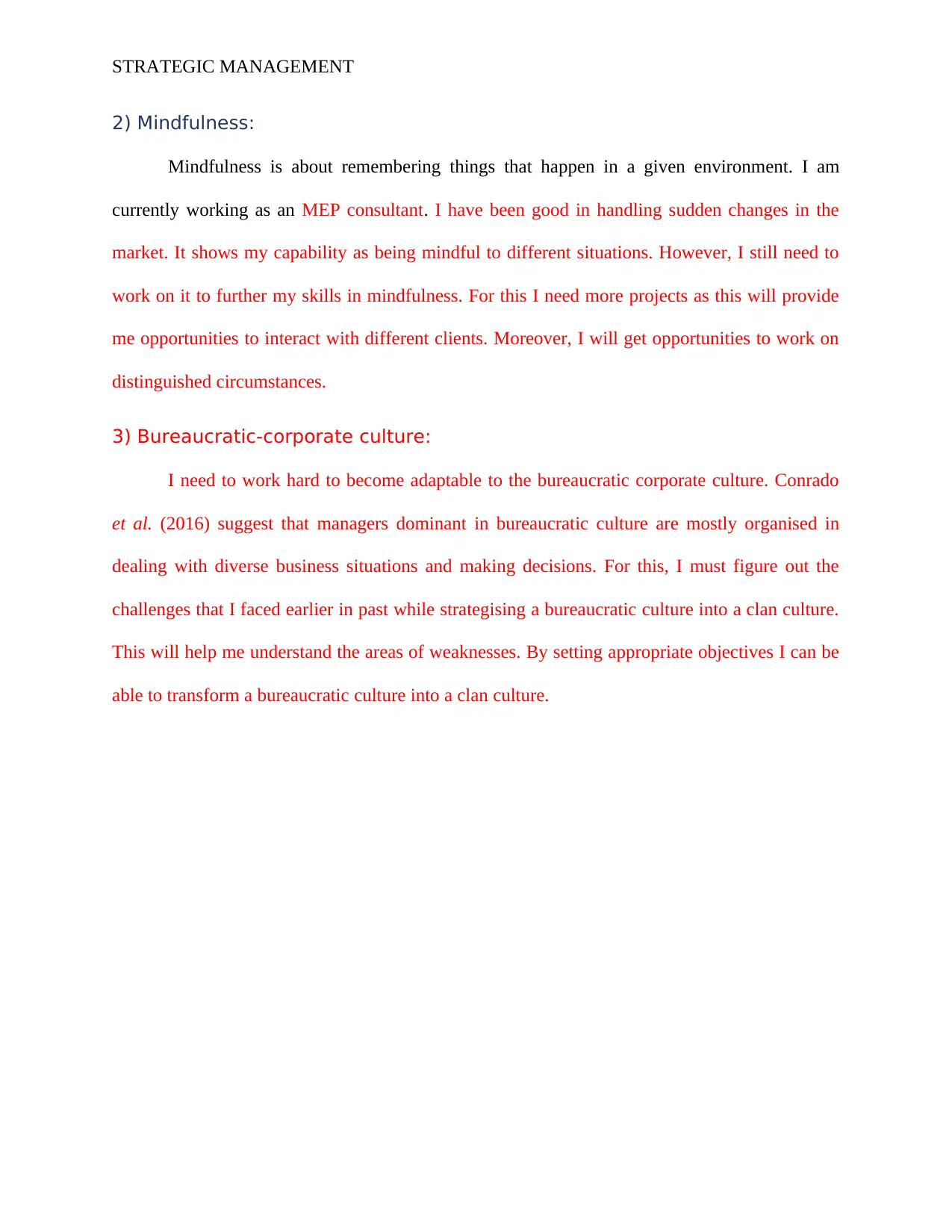
STRATEGIC MANAGEMENT
2) Mindfulness:
Mindfulness is about remembering things that happen in a given environment. I am
currently working as an MEP consultant. I have been good in handling sudden changes in the
market. It shows my capability as being mindful to different situations. However, I still need to
work on it to further my skills in mindfulness. For this I need more projects as this will provide
me opportunities to interact with different clients. Moreover, I will get opportunities to work on
distinguished circumstances.
3) Bureaucratic-corporate culture:
I need to work hard to become adaptable to the bureaucratic corporate culture. Conrado
et al. (2016) suggest that managers dominant in bureaucratic culture are mostly organised in
dealing with diverse business situations and making decisions. For this, I must figure out the
challenges that I faced earlier in past while strategising a bureaucratic culture into a clan culture.
This will help me understand the areas of weaknesses. By setting appropriate objectives I can be
able to transform a bureaucratic culture into a clan culture.
2) Mindfulness:
Mindfulness is about remembering things that happen in a given environment. I am
currently working as an MEP consultant. I have been good in handling sudden changes in the
market. It shows my capability as being mindful to different situations. However, I still need to
work on it to further my skills in mindfulness. For this I need more projects as this will provide
me opportunities to interact with different clients. Moreover, I will get opportunities to work on
distinguished circumstances.
3) Bureaucratic-corporate culture:
I need to work hard to become adaptable to the bureaucratic corporate culture. Conrado
et al. (2016) suggest that managers dominant in bureaucratic culture are mostly organised in
dealing with diverse business situations and making decisions. For this, I must figure out the
challenges that I faced earlier in past while strategising a bureaucratic culture into a clan culture.
This will help me understand the areas of weaknesses. By setting appropriate objectives I can be
able to transform a bureaucratic culture into a clan culture.
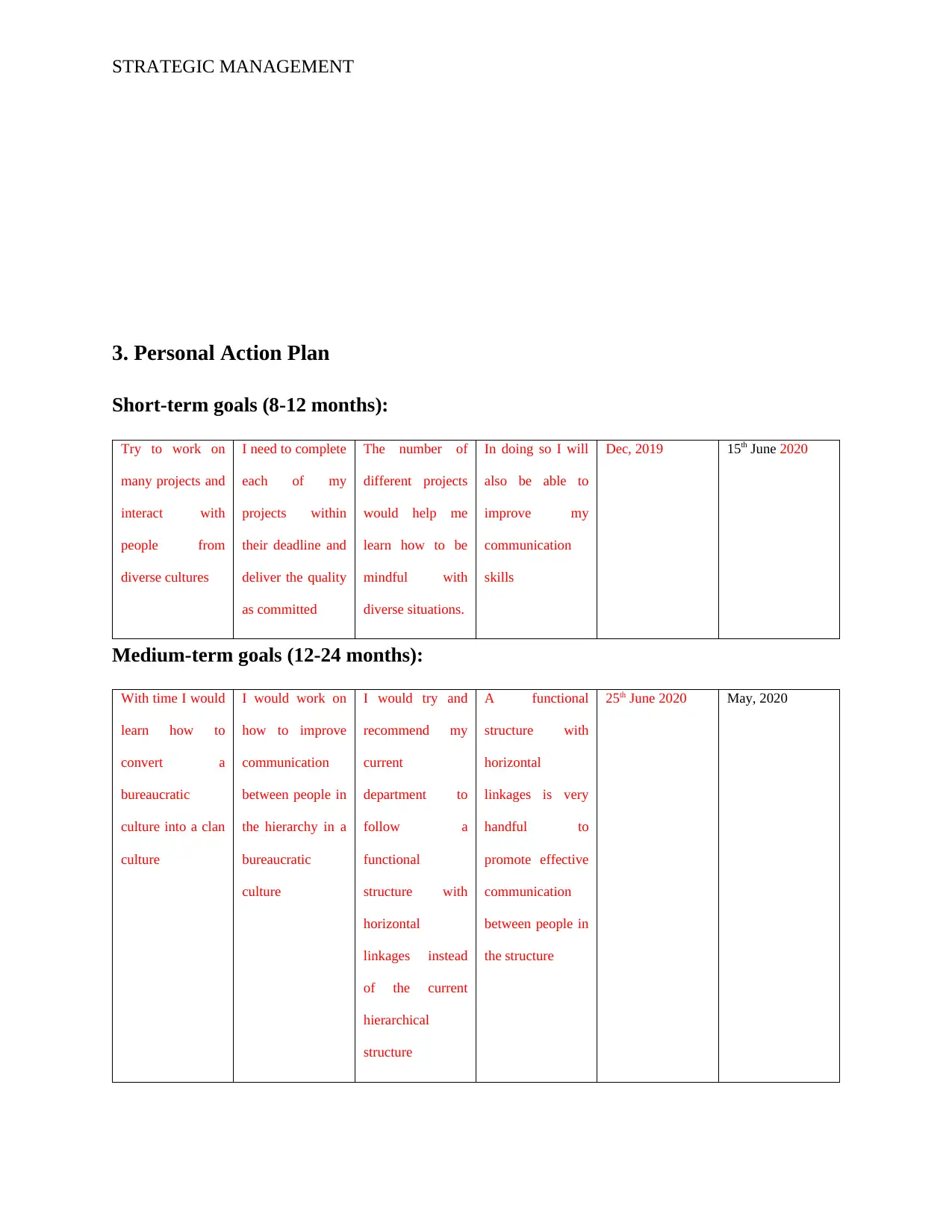
STRATEGIC MANAGEMENT
3. Personal Action Plan
Short-term goals (8-12 months):
Try to work on
many projects and
interact with
people from
diverse cultures
I need to complete
each of my
projects within
their deadline and
deliver the quality
as committed
The number of
different projects
would help me
learn how to be
mindful with
diverse situations.
In doing so I will
also be able to
improve my
communication
skills
Dec, 2019 15th June 2020
Medium-term goals (12-24 months):
With time I would
learn how to
convert a
bureaucratic
culture into a clan
culture
I would work on
how to improve
communication
between people in
the hierarchy in a
bureaucratic
culture
I would try and
recommend my
current
department to
follow a
functional
structure with
horizontal
linkages instead
of the current
hierarchical
structure
A functional
structure with
horizontal
linkages is very
handful to
promote effective
communication
between people in
the structure
25th June 2020 May, 2020
3. Personal Action Plan
Short-term goals (8-12 months):
Try to work on
many projects and
interact with
people from
diverse cultures
I need to complete
each of my
projects within
their deadline and
deliver the quality
as committed
The number of
different projects
would help me
learn how to be
mindful with
diverse situations.
In doing so I will
also be able to
improve my
communication
skills
Dec, 2019 15th June 2020
Medium-term goals (12-24 months):
With time I would
learn how to
convert a
bureaucratic
culture into a clan
culture
I would work on
how to improve
communication
between people in
the hierarchy in a
bureaucratic
culture
I would try and
recommend my
current
department to
follow a
functional
structure with
horizontal
linkages instead
of the current
hierarchical
structure
A functional
structure with
horizontal
linkages is very
handful to
promote effective
communication
between people in
the structure
25th June 2020 May, 2020
⊘ This is a preview!⊘
Do you want full access?
Subscribe today to unlock all pages.

Trusted by 1+ million students worldwide
1 out of 50
Related Documents
Your All-in-One AI-Powered Toolkit for Academic Success.
+13062052269
info@desklib.com
Available 24*7 on WhatsApp / Email
![[object Object]](/_next/static/media/star-bottom.7253800d.svg)
Unlock your academic potential
Copyright © 2020–2025 A2Z Services. All Rights Reserved. Developed and managed by ZUCOL.





